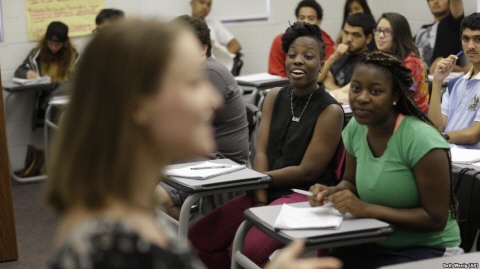
[전문 + mp3] / [받아쓰기]
Financial aid is an important resource for students who want to attend college in the U.S. but don’t have enough money. Financial aid is offered by banks, the government, and the school a student plans to attend. But research shows the amount of financial aid colleges and universities provide low-income students has decreased. The National Center for Education Statistics, or NCES, collects information about education across the country. Last year the NCES, a part of the Department of Education, reported that more than 41 percent of all full-time students attending college for the first time in 2014 received financial aid from their school. But the NCES report also shows the average amount of institutional aid for low-income students has decreased steadily from 1996 to 2012. The average amount of institutional aid given to the lowest-income students was $2,540 in 1996. The average amount given to the highest-income students was $3,327 in the same year. That indicates that students with the greatest need received less financial aid than higher-income students. In 2012, low-income students received an average of $5,300 while high-income students received an average of $7,800. Again, the students with the greatest need received less financial aid than higher-income students.
* financial aid = (대학생에 대한) 학자금 지원[융자]/ resource = 자산, 재료, 자원/ low-income = 저소득의/ steadily = 끊이없이, 꾸준히; 착실하게, 견실하게
Ben Miller is the Senior Director for Post-Secondary Education at the Center for American Progress, an organization that studies and reports on American society. Miller says the problem goes back earlier than 1996. He says the problem is colleges want to look better in rankings like the U.S. News and World Report, a media company that creates a list of what it calls “America’s Best Colleges.” The company bases the list on information like the average standardized test results of a school’s students. A college with higher average test results has a better chance of being higher on U.S. News and World Report’s list. Miller says higher-income students usually have higher test results and grade averages. Schools have begun to use their institutional aid to try to appeal to those types of students. When schools take students with better academic records and are able to turn other students away, they look more prestigious, he says. "The problem is, we haven’t come up with a good way to evaluate colleges on meaningful things. You can’t go out there and find out ‘What’s the college where I’m going to learn the most?’ or ‘What’s the college where I’m going to get the most skills for my money, that’s going to be my best value?’ And so instead we use a lot of things that we think might represent quality and value but really don’t necessarily." The College Board lists the average cost of universities in the U.S. They looked at the average cost for residents to attend a public four-year institution in their state. They found the cost was $9,410 for the 2015-2016 academic year. The average cost for a private four-year institution was $32,405 for the same year.
* post-secondary education = 중등 과정 후의 교육/ standardized test = 표준화 시험/ appeal to ~ = ~에 호소하다/ academic record = 성적(표)/ turn sb away (from ~) = (~에 들어오지 못하게) ~를 돌려보내다[쫓아 보내다]/ prestigious = 일류의, 명망 있는[높은]/ come up with ~ = (해답·돈 등을) 찾아내다[내놓다], 제시[제안]하다; ~을 생산하다/ evaluate = 평가하다












